Bobtail Antenna Rolf Merrettig (DL7ME). Encyclopedia of radio electronics and electrical engineering

Encyclopedia of radio electronics and electrical engineering / VHF antennas
 Comments on the article
Comments on the article
The article describes the developed modifications of the so-called Bobtail antenna, found in the American amateur radio literature, for the 2 m and 70 cm bands. The construction principle of the Bobtail is shown in Fig. 1.
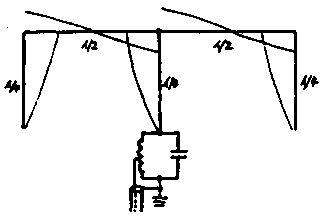
Ris.1
The antenna consists of a quarter-wave radiator and two external elements of the same length as the radiator, lying in the same plane. External elements are powered by antiphase half-wave lines and therefore the horizontal component of their radiation is suppressed. The antenna diagram is bidirectional (Fig. 2), with radiation maxima in directions perpendicular to the plane of the quarter-wave elements. The gain in gain, compared to GP, is about 5 dB.
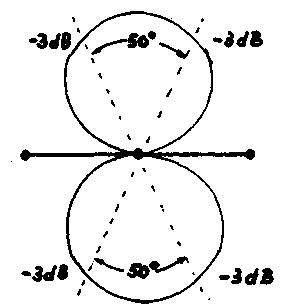
Ris.2
The modification of the antenna proposed by the author is, as it were, an "inverted" version of the Bobtail (Fig. 3) with a direct connection of a 50-ohm power cable. The exact position of the phase of the external elements in the "inverted" version is achieved by connecting the conductors of the half-wave lines to the screen of the coaxial cable at the feed point.
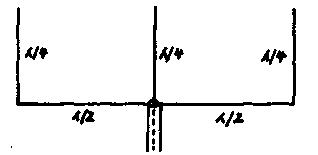
Ris.3
On the 70 cm band, the antenna works like 3/4l, and the extreme elements are fed by 1,5l lines. Figure 4 shows a "wire" version of the design, where ab + ab = 3,04 m of stranded copper wire (a = 1 m, b = 52 cm); c - emitter 52 cm long; d - three supporting PVC pipes with a diameter of 15 mm and a length of 54 cm; e - 8 self-tapping screws; f - extensions from a synthetic cable.

Ris.4
In Fig. 5 - a "hard" version of an aluminum profile and tubes, where a is the middle bar of a 15x15 mm profile 1 m long; b - side strips (profile 11x11 mm, length 60 cm); c - three vertical radiators from a tube with a diameter of 6 mm and a length of 56 cm; d - bayonet 50-ohm connector; e - screw cable clamp PG7; f - steel screws 3,5x13 mm for fixing external emitters.
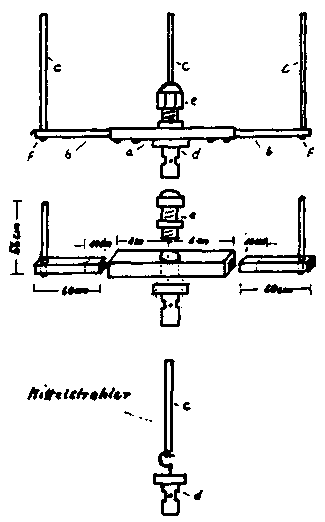
Ris.5
In the next modification, Rolf suggested using half of the Bobtail antenna (Fig. 6). In this case, however, the gain becomes 2 dB less, and the diagram is 25 ° wider (in the level of -3 dB), but a very compact design is obtained.
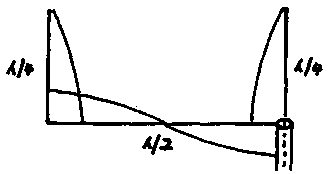
Ris.6
By adding a reflector, similar in design to the emitter, - increasing only the length of the vertical elements by 5%, the author received a unidirectional antenna (Fig. 7) with a gain of 6 dB (Fig. 8).

Ris.7
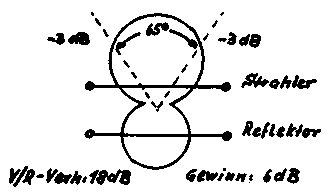
Ris.8
Figure 9 shows the design of a 2-element antenna, where a is a 50-ohm bayonet connector with a ground lobe; b - phasing line of copper insulated wire 1 m long with a diameter of 0,8-1 mm; c - two telescopic antennas from broadcasting receivers with threaded holes in the ends, pulled out to the required length; d - PVC pipe with a diameter of 25 mm and a length of 1 m; e - wooden plank 220x35x5 mm with two holders for PVC pipes; f - supporting PVC pipe with a diameter of 25 mm and a length of 22 cm; e - a suitable end fastening unit.
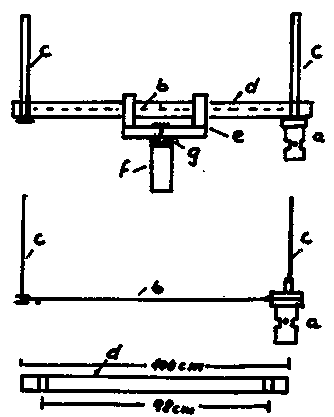
Ris.9
In Fig. 10 - the design of a unidirectional antenna, where a, b, c, d, e, f, g - similar to Fig. 79, and cg - the same telescopic antennas as c, but 5% longer, h - PVC pipe with a diameter 25 mm long 26 cm.

Ris.10
Literature
- "Funk" N 12/2000, p. 38,39; No. 1/2001, p. 42, 43
Publication: N. Bolshakov, rf.atnn.ru
 See other articles Section VHF antennas.in
See other articles Section VHF antennas.in
 Read and write useful comments on this article.
Read and write useful comments on this article.
<< Back
 Latest news of science and technology, new electronics:
Latest news of science and technology, new electronics:
A New Way to Control and Manipulate Optical Signals
05.05.2024
The modern world of science and technology is developing rapidly, and every day new methods and technologies appear that open up new prospects for us in various fields. One such innovation is the development by German scientists of a new way to control optical signals, which could lead to significant progress in the field of photonics. Recent research has allowed German scientists to create a tunable waveplate inside a fused silica waveguide. This method, based on the use of a liquid crystal layer, allows one to effectively change the polarization of light passing through a waveguide. This technological breakthrough opens up new prospects for the development of compact and efficient photonic devices capable of processing large volumes of data. The electro-optical control of polarization provided by the new method could provide the basis for a new class of integrated photonic devices. This opens up great opportunities for ... >>
Primium Seneca keyboard
05.05.2024
Keyboards are an integral part of our daily computer work. However, one of the main problems that users face is noise, especially in the case of premium models. But with the new Seneca keyboard from Norbauer & Co, that may change. Seneca is not just a keyboard, it is the result of five years of development work to create the ideal device. Every aspect of this keyboard, from acoustic properties to mechanical characteristics, has been carefully considered and balanced. One of the key features of Seneca is its silent stabilizers, which solve the noise problem common to many keyboards. In addition, the keyboard supports various key widths, making it convenient for any user. Although Seneca is not yet available for purchase, it is scheduled for release in late summer. Norbauer & Co's Seneca represents new standards in keyboard design. Her ... >>
The world's tallest astronomical observatory opened
04.05.2024
Exploring space and its mysteries is a task that attracts the attention of astronomers from all over the world. In the fresh air of the high mountains, far from city light pollution, the stars and planets reveal their secrets with greater clarity. A new page is opening in the history of astronomy with the opening of the world's highest astronomical observatory - the Atacama Observatory of the University of Tokyo. The Atacama Observatory, located at an altitude of 5640 meters above sea level, opens up new opportunities for astronomers in the study of space. This site has become the highest location for a ground-based telescope, providing researchers with a unique tool for studying infrared waves in the Universe. Although the high altitude location provides clearer skies and less interference from the atmosphere, building an observatory on a high mountain poses enormous difficulties and challenges. However, despite the difficulties, the new observatory opens up broad research prospects for astronomers. ... >>
 Random news from the Archive Random news from the Archive Oxygen on Mars
23.06.2018
In recent years, more and more ideas for the colonization of Mars have been put forward. Experts from all over the Earth are puzzling over how a person could live comfortably on the Red Planet, grow plants ("and apple trees will bloom on Mars") and animals, have children and engage in scientific research.
One of the most significant problems, of course, is the lack of oxygen on Mars, which we breathe. Obviously, taking enough of it from Earth is not an option.
Scientists from the US unexpectedly found a potential solution to this issue. In their opinion, deep-sea cyanobacteria living in the oceans can probably cope with such a daunting task. Thanks to the process of photosynthesis, they are theoretically capable of absorbing carbon dioxide under extreme conditions for humans, releasing oxygen.
The so-called blue-green algae are surprisingly resilient: they are found in Antarctica, in the incredibly hot Death Valley, and even on the outer skin of the International Space Station.
Elmars Krausz, one of the authors of the study, says: "This may sound like pure science fiction to many of us, but large space agencies and some private companies are already interested in testing our idea in practice. In theory, bacterial photosynthesis is really capable of launch oxygen production on Mars."
|
 Other interesting news:
Other interesting news:
▪ Chip IR25750L for current measurement
▪ Smart speaker Huawei Sound SE
▪ Kateeva YIELDjet Explore Pro Inkjet System
▪ XNUMXD graphene transistors
▪ Wash without powder
 News feed of science and technology, new electronics
News feed of science and technology, new electronics
 Interesting materials of the Free Technical Library:
Interesting materials of the Free Technical Library:
▪ section of the website Basics of First Medical Aid (BFA). Selection of articles
▪ article We are few, but we are in vests. Popular expression
▪ article Why did Disney stop using feminine words in cartoon titles? Detailed answer
▪ article Cargo trailer for a motorcycle. Personal transport
▪ article Electrical insulating varnishes and enamels. Encyclopedia of radio electronics and electrical engineering
▪ article General information for a beginner magician. Focus Secret
 Leave your comment on this article:
Leave your comment on this article:
 All languages of this page
All languages of this page
Home page | Library | Articles | Website map | Site Reviews

www.diagram.com.ua
2000-2024







 Arabic
Arabic Bengali
Bengali Chinese
Chinese English
English French
French German
German Hebrew
Hebrew Hindi
Hindi Italian
Italian Japanese
Japanese Korean
Korean Malay
Malay Polish
Polish Portuguese
Portuguese Spanish
Spanish Turkish
Turkish Ukrainian
Ukrainian Vietnamese
Vietnamese










 Leave your comment on this article:
Leave your comment on this article: